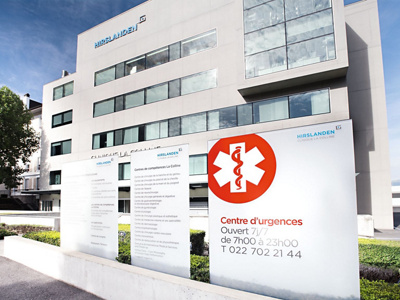The Emergency Centre opened in 2012. Its attendance increases every year and more than 13,000 patients were admitted in 2017. How do admissions work? What types of emergencies are treated? What is the application of the Swiss sorting scale? The nurse in charge of the emergency and endoscopy unit answers our questions.
The nurse in charge of the emergency and endoscopy unit answers our questions.

- Can you explain how emergency care takes place?
When patients arrive at the Emergency Department, they come to the reception desk and receive an intake form that they are asked to complete. A copy of the identity card as well as the insurance card is also made at this time.
When the administrative entry has been made, the patient is evaluated by the receiving nurse who takes an anamnesis (medical history of the patient) to identify his main complaint and assess his degree of urgency.
- What types of insured persons can be covered at Clinique La Colline's Emergency Centre?
We can take care of all patients regardless of their insurance. The differentiation between the different insurance schemes will only be made if hospitalization is necessary.
- What is sorting scale ?
We work with the Swiss Sorting Scale (EST). It is a tool that allows us to determine a degree of urgency taking into account the clinical signs of the patient, the complaints he expresses, his history and his vital constants.
There are 4 degrees of urgency, each degree corresponds to a maximum time of care.
- Degree 1: A life-threatening emergency that requires immediate medical attention.
- Degree 2: Major emergency with potential life-threatening risk, requires medical attention within 20 minutes.
- Degree 3: Non-vital emergency, requires further examinations and/or investigations.
- Degree 4: Emergency without particular risk, management may be postponed.
- What types of emergencies are treated ?
We receive all types of medical and surgical emergencies, patients can present themselves by their own means but also be referred by ambulance services.
We have communicated to the ambulance services the acceptance criteria for patients, which avoids misdirections. For example, they do not refer us to patients who require specialized care, such as coronary angiography (visualization of the arteries of the heart), intensive care or neurosurgery.
At the Colline emergency department, the majority of patients are rated with degrees of urgency 2 or 3, we also regularly take care of patients in life-threatening emergencies (degree 1).
- What is the average waiting time?
Les urgences de la Colline is a member of the Geneva Emergency Network. You can check the waiting times in real time on the website urgences-ge.ch
The average waiting time is 40 minutes and the average transit time is two hours, which is very short for an emergency department.
- What challenges do you face ?
The main challenge at the moment is the work on the flow of patients to the emergency room. We put procedures in place to reduce the passage time and length of stay with advance procedures (radio, clinical routes).
The emergency team has recently experienced a lot of changes in staff, so we must train the newcomers but also instil a team spirit in order to create a cohesion that is essential in moments of tension that we can encounter especially when we are taking care of a vital emergency.
In the same vein, it is also essential to harmonize the practice of caregivers so that the service provided to patients is more homogeneous.
- How do you work in collaboration with the other centers of the clinic ?
Collaboration with the various departments and specialists is done by the doctors of the emergency department.
Patients are referred to the various specialists after their visit to the emergency room following care. Specialists also sometimes come directly to our department to consult patients.
Visit the Emergency Centre website
-
Adult Emergency Centre
Open 7/7 and public holidays: 7h to 11h -
Center for Gastroenterology and Digestive Endoscopy
Dr. Bertolini +41 22 347 46 91Avenue de la Roseraie 76A 1205 Geneva
David.Bertolini@hirslanden.ch
Dr. Morard +41 22 346 19 93
Isabelle.Morard@hirslanden.ch
Dr. Nguyen +41 22 347 55 66
Thai.NguyenTang@hirslanden.ch -
Center for Plastic, Reconstructive and Aesthetic Surgery
Avenue de Champel 24
1206 Genève -
Center for Sports and Exercise Medicine
Chemin Thury 7A
1206 Genève -
Dermatology Center
Dr. Campanelli +41 22 702 22 82Avenue de la Roseraie 76 A 1205 Geneva
Dr. Pournaras Dinichert +41 22 702 22 72 -
General Surgery Center
Avenue de la Roseraie 76A
1205 Genève

